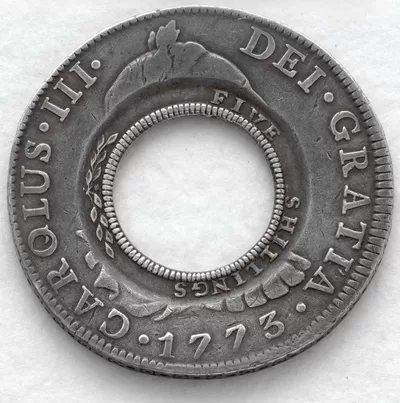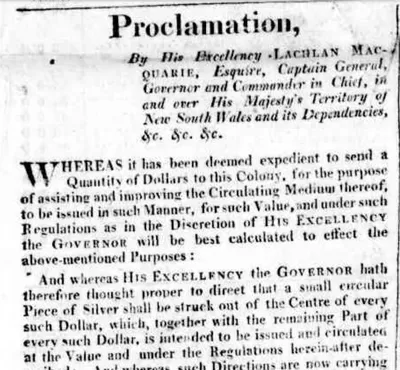The “Holey Dollar” is one of the most historically significant coins in Australian numismatics. It has a unique history and is an iconic symbol of early Australian currency.
The Holey Dollar was created in 1813 during the British penal colonial era of New South Wales. Governor Lachlan Macquarie ordered the conversion of Spanish silver dollars into two distinct coins, creating the Holey Dollar and the Dump.
To make the Holey Dollar, the center of the Spanish silver dollar was punched out, leaving a hole in the coin. The inner coin, or “Dump,” which was the punched-out piece, was valued at 15 pence, while the outer ring, known as the Holey Dollar, was valued at five shillings.
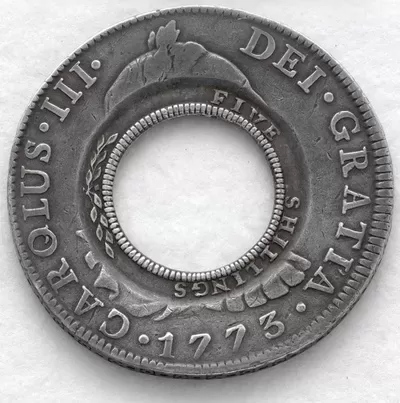

Bligh and the Rum Rebellion
The primary goal of creating Holey Dollars and Dumps was to address the shortage of currency in the colony.
New South Wales had turned to unconventional means of trade, including the use of promissory notes (IOUs), land transactions, and even rum as a form of exchange.
This unconventional system was facilitated by the officers of the New South Wales Corps, the Rum Corp, who wielded immense power and influence, largely through corrupt practices, since the colony was established two decades earlier.
Reverse of Holey Dollar, New South Wales, 1813, Sir William Dixson, Numismatic Collection, State Library of New South Wales CC BY-SA 3.0 au
Despite the best efforts of Governors King, Hunter, and Bligh to regulate the trade in spirits and land, the officers had amassed significant wealth and clout. The payment of farmers and labourers in rum had led to widespread alcoholism, and the colony was in a state of constant inebriation and debauchery.
When Governor William Bligh, already infamous as ‘Captain Bligh’ during the mutiny on the Bounty, tried to curb the power of the Rum Corp, they staged a successful military coup – The Rum Rebellion of 1808.
In 1813, the newly appointed Governor Lachlan Macquarie had a cunning plan to solve this predicament.
Macquarie procured £10,000 worth of Spanish dollars, with the objective of stabilising the economy, eradicating the use of rum as a de facto currency, and wresting control away from the influential elite associated with the New South Wales Corps.
These coins, equivalent to 40,000 Spanish dollars, arrived on November 26, 1812, aboard the merchant ship the Samarang.
To prevent these coins from leaving New South Wales, their centres were punched out, creating two distinct coin issues, and in doing so, earning the government a tidy profit.
The Holey Dollar and Dump were officially recognised as legal currency in New South Wales on 10 July 1813, and their use continued until they were officially demonetised in 1829.


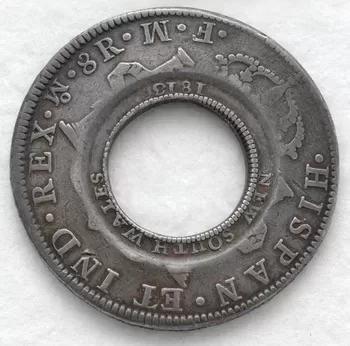

Reverse (left) and obverse (right) of Holey Dollar, New South Wales, 1813, Sir William Dixson, Numismatic Collection, State Library of New South Wales CC BY-SA 3.0 au
The rare Holey Dollar and Dump coins
The Holey Dollar features the crowned bust of King Charles III of Spain on the obverse and the Spanish coat of arms on the reverse. The Dump bore the design of five corn stalks and was stamped with the words “New South Wales” and the date.
Holey Dollars and Dumps are highly sought after by collectors due to their historical significance and rarity. They represent a unique chapter in the history of Australian currency.
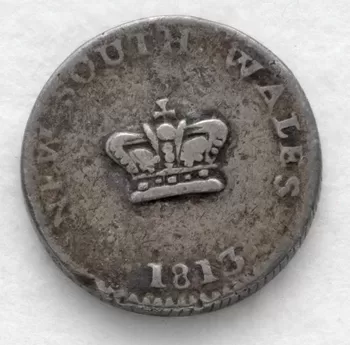



Holey Dollar dump: Obverse (left) and Reverse (right). New South Wales, 1813, Numismatic Collection, State Library of New South Wales CC BY-SA 3.0 au
Experts estimate that only 350 holey dollars and 1500 dumps remain. Holey Dollars and Dumps are now highly collectible and are often featured in museums, private collections, and numismatic exhibitions.
The authenticity and condition of Holey Dollars and Dumps are crucial factors in determining their value. Professional grading and authentication services are often used to assess these coins.
The Holey Dollar is a testament to the resourcefulness and ingenuity of early colonial authorities in Australia. It serves as a symbol of Australia’s early monetary system and is considered a valuable artifact of Australian history.
They are regarded as some of the most important and historically significant coins in Australian numismatics, and they continue to capture the fascination of collectors and historians alike.
Further Reading
Rum Rebellion: a Study of the Overthrow of Governor Bligh by John Macarthur and the New South Wales Corps, 1937 Hardcover, 2021 by Herbert Vere 1894-1965 Evatt
Rum Rebellion, 1981 reprint of 1943 classic by H.V. Evatt
Mutiny on the Bounty: A saga of sex, sedition, mayhem and mutiny, and survival against extraordinary odds, 2020 by Peter FitzSimons
Pirate Guide to Collecting Australian Coins: 2023/2024 Edition, November 2, 2023 by Damian Walker
Renniks Australian Coin & Banknote Values 31st Edition Hardcover
A Guide Book of United States Coins 2022 75th Edition Spiral-bound by Garrett, Jeff, Bowers
Paper Money – North America – Australia – Oceania: COLOR PHOTOGRAPHY Paper money – Old and Rare Banknote (Banknotes of the world)
Disclaimer: We may earn a small commission from sales at Amazon
Related stories
Our feature stories on Numismatics, coin collecting
Collecting 1937 & 1938 Australian Crown coins
The Top 20 rarest and most valuable US coins
The intriguing tale of the 1933 Double Eagle gold coin
Numismatics: Fake Coins to Watch For
Explore the Art of Belly Dancing
Police Ephemera ° The value of Victorian reward posters
‘Central Bank Digital Currency’ is a new digital form of money issued by RBA
What are the world’s largest and famous gold nuggets?

